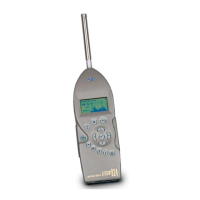7-14 824 Reference Manual 9/29/09
NOTE: In many of the options below,
notice the use of a shorthand identifier
which includes the first letters of the
various events along with the plus +
symbol. The plus symbol indicates a
logical “OR” function between events.
In other words, if for a given option, any
one of the listed events occurs alone or in
combination with another event, the
logic output will turn on.
The Logic Output setting provides the following options:
Off -
The Logic Output is disabled.
RMS -
The Logic Output turns on when an RMS
exceedance event occurs. An RMS exceedance
event occurs when the RMS sound pressure level
(SPL) exceeds the threshold set by the SPL Trig-
ger Level setting. The Any-Data SPL used is the
one specified by the Weight and Detector settings
Peak -
The Logic Output turns on when the
instantaneous peak level (Peak-I) specified by the
Peak Weight setting is over the Peak-1
Exceedance Level, or when the instantaneous
weighted peak level (Peak-II) specified by the
Weight setting is over the Peak-2 Exceedance
level.
R+P -
The Logic Output turns on when either an
RMS or Peak exceedance event occurs.
Intv -
The Logic Output turns on when an interval
begins.
R+I -
The Logic Output turns on when an RMS
exceedance event occurs or when an interval
begins.
P+I -
The Logic Output turns on when any peak
exceedance event occurs or when an interval
begins.
R+P+I -
The Logic Output turns on when either
an RMS or peak exceedance event occurs or when
each interval begins.
The A:D (or ‘A’) functions are for
compatibility with systems that have
analog data acquisition, generally
used to record weather metrics.
A:D -
The Logic Output turns on when an event
on one of the A:D channels occurs. These A:D
channels are typically used for weather monitor-
ing.
R+A -
The Logic Output turns on when an RMS
exceedance event occurs or when an event occurs
on one of the A:D channels.

